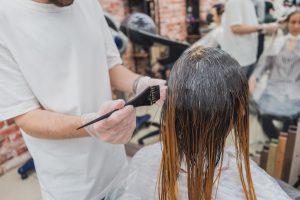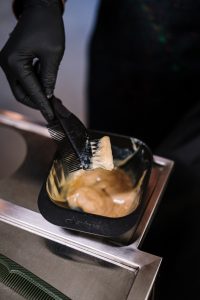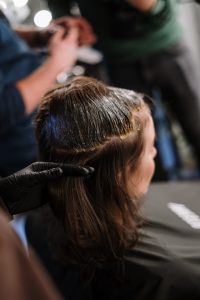Achieve the Best and Safest Hair Color Results

With very few exceptions, hair dyes are not clean. Even the most natural, herbal, and organic products in Europe contain dangerous chemicals. We love our vibrant tresses, but we want to know what dangers we’re exposing ourselves to when coloring, ideally making the process more transparent and less risky.
Is dyeing your hair as damaging to you as smoking? Not quite, and the effects of it have not yet been thoroughly explored. Paraphenylenediamine (PPD) is a toxic component present in most permanent dyes (ranked seven out of ten for its toxicity on ewg.org) as well as many organic and natural formulas. Out of all the components found within these products, PPD is one that should raise red flags for anyone considering coloring their hair.
Learn the 8 Essential Tips for Hair Dyeing with Safety in Mind!
1
Make the switch to blonde! Going light can help you avoid the high levels of PPD that are more common when sporting darker shades.
2
If you’d rather not deal with the hassle of gray hair, hold off on coloring your locks until it begins to show.
3
Prolong the need to dye your hair with Color-Wow’s amazing brush-on powder. Not only will it cover root regrowth seamlessly, but it’ll remain in place until you wash it out, allowing you to extend each color session from time to time.
This is a brilliant way of reducing exposure throughout your life, too! Additionally, condition regularly, wear hats when necessary, and avoid chlorine for maximum vibrancy and healthiness so that coloring isn’t required as often.
Try these:
4
When you’re performing hair coloring at home, be sure to stick to the directions. Wear those inconvenient gloves for your defense—especially with color kits designed for domestic use—and minimize exposure whenever feasible.
5
If you begin to experience any signs of an allergic reaction following hair coloring, it’s essential that you seek medical help right away. This is not in reference to minor irritation or even burns from bleach, but rather direct symptoms such as swelling and/or dizziness accompanied by difficulty breathing.
Even those who have been regularly visiting the salon for years can become prone to PPD-induced anaphylaxis, while first-time colorists are also at risk of a similar reaction.
For people who’ve already undergone a patch test and still experienced adverse reactions, it is paramount to take even the slightest allergic sensation with the utmost gravity. An anaphylactic reaction can be fatal, so it is advised to treat this medical emergency as soon as possible.
6
During your initial trimester of pregnancy, it is best to avoid coloring altogether. If you are seeking an option for colored hair throughout the rest of your term, converse with a professional colorist about possible alternatives that can be utilized without impacting the scalp. With various techniques and products available on the market today, there should not be any difficulty in achieving beautiful locks while maintaining safety during this special time!

7
To reduce the risks of coloring your scalp, opt for highlights instead; they don’t touch your scalp at all. Additionally, if you only have up to 25 percent gray hair, consider targeting just those strands and leaving the rest natural. This way, you can still get a dramatic change without taking on the full tinting process!
8
Ditch the PPD-infused formulas for non-PPD ones. Although it’s not guaranteed that these options are completely safe, you’ve at least managed to steer clear of one particularly harmful and toxic substance.
For temporary coloring effects, Christophe Robin offers a fantastic gel color selection; while Hairprint provides an even more permanent solution without any PPD—even though this method may be slightly complicated to apply on your own, trust us when we say it’s totally achievable!
Temporary Color Gel – Golden Blonde
Temporary Color Gel – Dark Blonde
Temporary Color Gel – Light Chestnut
Temporary Color Gel – Dark Chestnut
The Dangerous Of PPD
PPD, a potent chemical sensitizer should not be taken lightly – it can cause severe allergic reactions beyond the likes of itchiness or redness. Anaphylactic reactions have been reported as fatal in cases where a patch test has shown no ill effects, even if this is the first time applying hair color or after many years of using the same product without issue.
The patch test has been a source of contention, and many are engaging in research to determine if it increases the chances of an allergic reaction or carries any other benefits.
In 2001, a study from the University of Southern California demonstrated that women who colored their hair monthly for fifteen years or more had an alarming 50% higher risk of bladder cancer than other groups. In 2004, it was revealed in the International Journal of Cancer that men and women who consistently utilized PPD-based hair dyes over fifteen-year periods were five times more likely to suffer from bladder cancer than others. Also concerning is its link to non-Hodgkin’s lymphoma, which was established by the American Journal of Epidemiology in 2008.
Research from Linköping University in Sweden reveals that PPD may have a negative impact on the immune system, and women who’ve been coloring their hair for two decades or longer are twice as likely to develop rheumatoid arthritis. This assessment was published in the journal Annals of Rheumatic Diseases. Unfortunately, FDA regulations don’t provide much oversight when it comes to regulating PPD compared to other cosmetics.
According to the Food and Drug Act, by-products of petroleum combustion, such as PPD, are deemed exempt from any rules related to poisonous or deleterious substances. The FDA website expressly states that no action can be taken against a coal-tar hair dye if it has appropriate cautionary labeling along with accurate instructions for users on doing their skin test before dying their hair.
The European Union and Environmental Protection Agency have both classified PPD as a hazard for wildlife and the environment, an irritant when inhaled or in contact with skin, an immune system toxicant, and highly detrimental to animals even at moderate doses. The EPA has also identified it as a known respiratory toxicant in humans without any studies yet conducted on its impacts at low doses.
Taking all of this into consideration, many studies conducted on subjects who dyed their hair during the pre-1980 era need to be looked at with a critical eye. While formulas have undoubtedly advanced since then, it is important to note that PPD still exists in most types of hair color today. This is due to the lack of enforcement of transparency from the FDA’s side when it comes to shampoo and dye labels; thus failing to provide companies (natural or otherwise) any incentives for improvement.

Although some people have had positive results with pure henna, other formulations may include heavy metals, salts, and/or PPD (paraphenylenediamine), which is often referred to as “black henna.” Be mindful that this type of dyeing agent can be hazardous if used for temporary tattoos.
Although some may argue that even PPD-free formulas can contain carcinogenic toxins such as benzenes, without proper regulation from the FDA it’s difficult to decipher risks and benefits. As innovation in beauty products continues to evolve, so does hair color technology, leaving its chemical content vastly different than when our elders used them decades ago. It is indeed a continuously moving target!
For Long-Lasting Color, Combine Protective Conditioner and Mild Shampoo
When it comes to coloring your hair less often, taking good care of it is key. Reach for clean and ultra-gentle products that provide maximum moisture, just like you would with your skin! 100%Pure shampoo-and-conditioner set provides the perfect combination of two top-notch hair care products. Not only do they smell divine but their nourishing formula is completely free from any dangerous ingredients. With this duo, you can trust that your hair will be getting all the love it needs while helping reduce how frequently you have to color or dye!
The incredible, nourishing combination of kelp and mint has captured the hearts (and heads) of all our blog team members, no matter what type of hair they have. Grown in pristine surroundings and processed by hand, this duo refreshes your scalp while smoothing and strengthening each strand. It’s also a great moisturizer that reduces frizziness as it adds shine and bounce to your locks! Not only does it smell divine, but you’ll be amazed at how glossy yet voluminous your hair becomes after using these products together!
Pamper your locks with this ultra-luxurious shampoo! Formulated from the finest plant extracts, this gentle cleanser will cleanse without removing natural oils that provide luster and shine. Glycerin helps sustain hair’s moisture balance, while babassu Seed Oil deeply conditions dry scalp and strands. Panthenol penetrates to hydrate for an overall softer feel like never before!
Infused with nourishing pro-vitamin B5 and coconut oil, this ultra-rich conditioner will transform dry hair into silky, moisturized locks. Massage the product onto the mid-lengths and ends of your hair for two to three minutes before rinsing it off swiftly under warm water. Suitable even for color-treated tresses, this sulfate-free formulation is gentle enough yet powerful enough to deliver a clean wash!
This luxurious set of hair essentials comes in chic, large pump bottles that look fantastic anywhere from the shower to the bathroom. The shampoo not only resets your scalp’s microbiome but also creates a magnificent lather that envelops and lightly hydrates both your head and tresses. Meanwhile, its accompanying conditioner smooths out any imbalances while restoring moisture levels for velvet-smooth, glossy results—all with an effervescent scent!
This pre shampoo glow serum is the key to your most remarkable, silky, and vibrant locks. It’s like a miracle for my mane—I drench it in this hair-saving potion for 20 minutes before I shampoo (a perfect excuse to squeeze in a workout! ), which quickly tames frizziness and repairs damage while also strengthening my hair so that its radiance beams from within. This special Organic Rosehip Oil prewash ritual is designed to reduce frizz, improve the texture and shine of your hair, moisturize it deeply, and make detangling an effortless task, no matter what type or texture your hair has!




